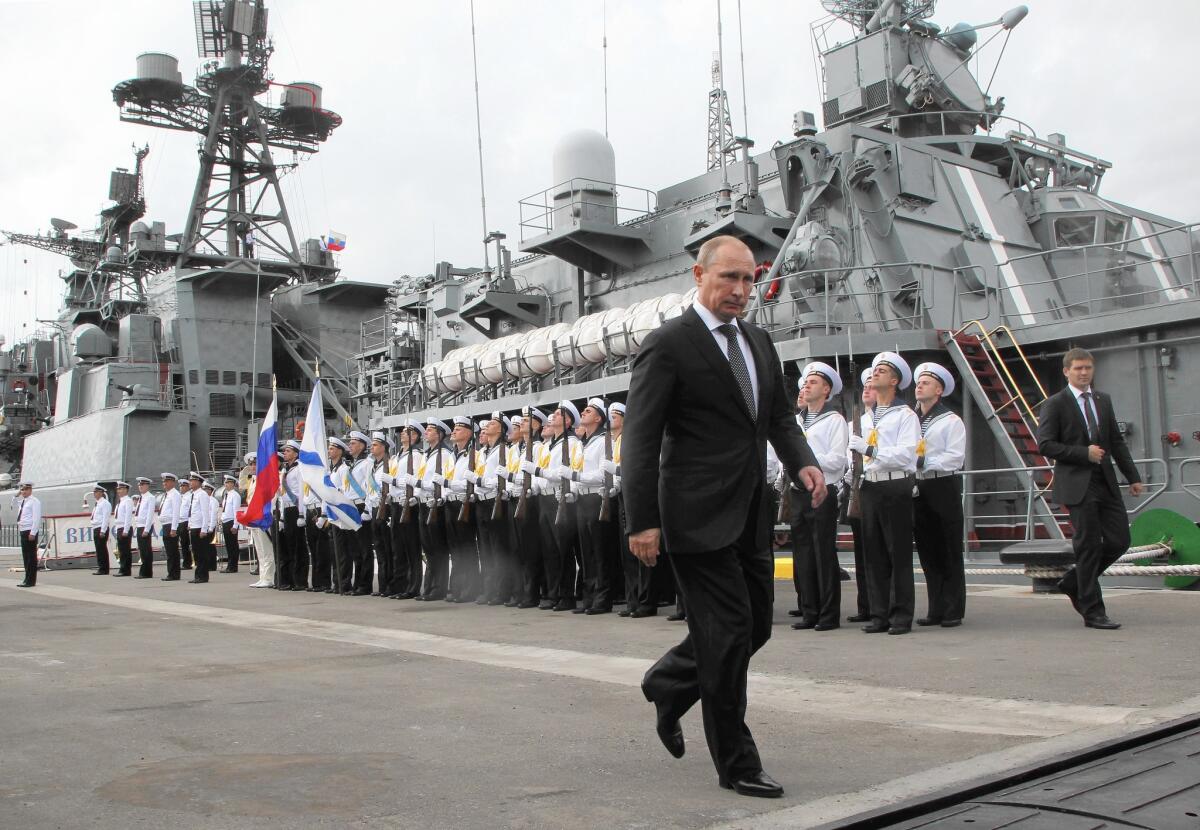Pentagon official lists militants, Russia and China as threats to U.S.

- Share via
Reporting from Washington — Russian military activity is at its highest level since the Cold War, destructive state-sponsored attacks on U.S. computer systems are on the rise and Islamic State is expanding into unstable parts of North Africa, the Pentagon’s top intelligence official told Congress on Tuesday.
The warnings came against the grim backdrop of the release of a video that appeared to show a Jordanian military pilot being burned alive by his Islamic State captors, and a day after President Obama proposed reversing a five-year decline in military spending to help battle the Sunni Muslim extremists who control parts of Iraq and Syria.
Lt. Gen. Vincent Stewart, director of the Defense Intelligence Agency, said the militant group Islamic State has steadily extended its reach despite near-daily U.S.-led coalition airstrikes that began in August. More than two dozen extremist groups around the world have merged with or pledged allegiance to Islamic State, and its ranks continue to swell with new recruits.
“With affiliates in Algeria, Egypt, Libya, the group is beginning to assemble a growing international footprint that includes ungoverned and undergoverned areas,” Stewart, who took command of the Pentagon’s spying arm last month, told the House Armed Services Committee in an annual review of national security threats.
The militant group’s appeal apparently extends to Canada. Police there on Tuesday charged three men suspected of having ties to an Islamic State recruiting cell in Ottawa. The three reportedly were trying to travel to Syria and were not plotting an attack in Canada when they were arrested.
Rear Adm. John Kirby, a Pentagon spokesman, told reporters that Islamic State “has a fairly evangelical strain about it.”
“They want to metastasize. They want to grow. They want to increase their influence,” Kirby said. “We’re watching it as closely as we can.”
Stewart told the House committee that the Al Qaeda terrorist network’s dwindling and aging core leadership is “focused on physical survival” and is competing with Islamic State, a breakaway faction, for followers and funding.
But Al Qaeda is “trying to retain its status as vanguard of the global extremist movement,” he said, and thus remains highly dangerous. Analysts expect some of its affiliates to plot attacks against Western planes and facilities.
Its offshoot in Yemen, known as Al Qaeda in the Arabian Peninsula, claimed responsibility last month for the shooting rampage that left 12 people dead in the offices of Charlie Hebdo, a satirical magazine in Paris that published cartoons about Islam.
The United States reportedly has launched three drone strikes against Al Qaeda targets in Yemen since Jan. 25, when President Obama announced that there would be no letup in U.S. counter-terrorism operations despite a power struggle that toppled the American-backed government in Sana, the capital.
A separate U.S. drone strike last week killed a senior Shabab leader near Mogadishu, Somalia’s capital, according to Pentagon officials who were not authorized to speak on the record. They said that Yusuf Dheeq, Shabab’s chief of intelligence and external operations, was targeted and that no civilians were killed.
Shabab, an Al Qaeda-affiliated insurgent group, has threatened the U.S.-allied government in Mogadishu and expanded into neighboring Kenya. The group claimed responsibility for the September 2013 siege at an upscale shopping mall in Nairobi, Kenya’s capital, that left more than 60 people dead.
The greatest potential danger to the United States, however, comes from Russia and China, Stewart told the committee. Terrorist groups such as Islamic State and Al Qaeda “can pose us harm,” he said, but “they don’t pose an existential threat.”
Russia under President Vladimir Putin has developed new missile technology, including modernizing its “road-mobile” intercontinental ballistic missiles. Russia also has established new air bases in its Arctic region and announced the creation of a new military command in the Arctic.
Moscow also has increased its use of spy planes and surveillance ships far from its borders and has resumed sending warships around the globe. Analysts expect more Russian air and naval operations in the Caribbean and Mediterranean seas this year, Stewart said.
China and Russia “are conducting anti-satellite research and developing anti-satellite weapons, with the intent of denying the U.S. the use of space in the event of conflict,” Stewart said.
“At low cost, with limited technical expertise, our adversaries have the potential to cause severe damage and disruption to U.S. systems, leaving little or no footprint behind,” he said.
The evolving mix of terrorist, cyber and military threats are the “most challenging of our lifetime,” Stewart said. “I don’t see it getting any easier.”
Times staff writer W.J. Hennigan contributed to this report.
More to Read
Sign up for Essential California
The most important California stories and recommendations in your inbox every morning.
You may occasionally receive promotional content from the Los Angeles Times.














